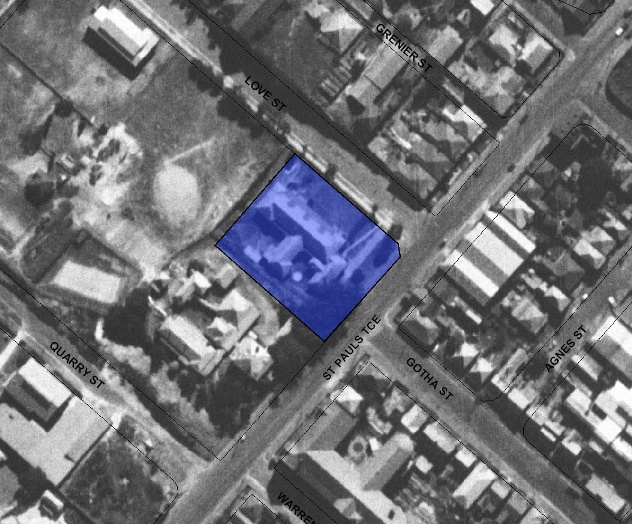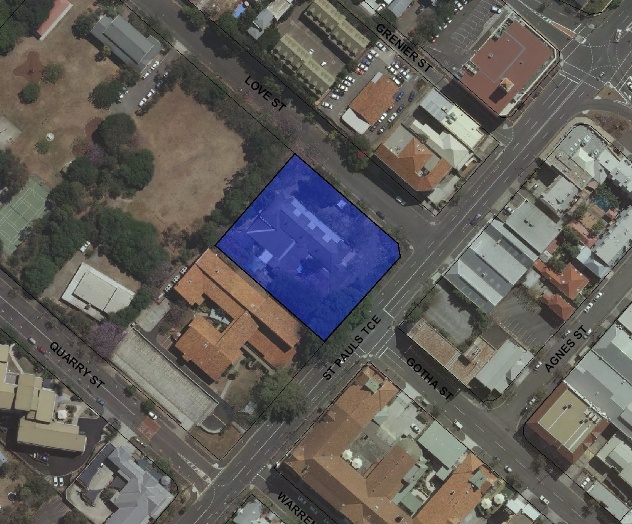Addresses
Type of place
Preschool
Period
World War II 1939-1945
Style
Bungalow
Addresses
Type of place
Preschool
Period
World War II 1939-1945
Style
Bungalow
Lot plan
L3_RP77577
Key dates
Local Heritage Place Since —
Date of Citation —
Construction
Roof: Corrugated iron;Walls: Timber
People/associations
Aubrey Horswill Job (Architect)Criterion for listing
(A) Historical; (C) Scientific; (D) Representative; (H) Historical associationInteractive mapping
Lot plan
L3_RP77577
Key dates
Local Heritage Place Since —
Date of Citation —
Construction
Roof: Corrugated iron;Walls: Timber
People/associations
Aubrey Horswill Job (Architect)Criterion for listing
(A) Historical; (C) Scientific; (D) Representative; (H) Historical associationInteractive mapping
History
The Lady Gowrie Child Centre Brisbane opened to 17 enrolled children on 17 June 1940. Just over a month later on 27 July Lord Gowrie, Governor-General of Australia, and Lady Gowrie visited the site and officially opened the centre in front of nearly 400 people. With a gold key presented to her by architect Mr A H Job, Lady Gowrie said, “I declare this building open. May happiness, unity and loyalty reign within its walls.”1
The Centre in Brisbane was the third of six opened by Lady Gowrie at public gatherings in each capital city. The first to open was in Carlton, Melbourne in December 1939, then Erskineville, Sydney in April 1940, Hobart also in July 1940, then Adelaide and Perth later in the year.
Established by the Australian Commonwealth Government as demonstration centres for children's programs, the Commonwealth of Australia acquired the land on St Paul’s Terrace on 13 August 1939 specifically for ‘health purposes’ under the Lands Acquisition Act 1906 – 1936.1 The Lands Acquisition Act, similarly to the Commonwealth Act, provided a means of acquiring land for public purposes, in this instance a child care centre.
Constructing centres for the care and wellbeing of children of the nation was not unjustified. In the early 1900s, infectious diseases were debilitating the population and the Commonwealth gradually became involved in the development of strong and healthy Australians, particularly mothers and children. In 1912 a £5 ‘baby bonus’ or maternity allowance was introduced but high infant and mortality rates were recorded.1 In response to the influenza pandemic and dire state of health of the nation, the Commonwealth Department of Health was founded in March 1921.
The Great Depression (1929 – 1933) forced the Department to cut activities including maternal and infant hygiene and when Billy Hughes became Minister for Health and Repatriation for a second time in 1936, he expressed his serious concern about the falling birth rate and high maternal mortality rate for the future of the nation. His famous ‘populate or perish’ campaign prompted the setting up of a fund to promote the welfare of mothers and infants.
Brisbane’s poverty-stricken children were closely observed by a group of well-meaning leaders of society. Reverend Loyal Lincoln Wirt who, after arriving in 1905, established the Creche and Kindergarten Association (C&K) two years later.1 The kindergarten movement had started in Sydney in the 1890s and by 1910 there were 32 in Australia. As interest in child health, social conditions and parenting practices developed throughout the 1920s and 1930s, a more scientific approach in bringing up children developed. C&K was employing the most modern educational ideas and experimented with these at the Rosalie and Paddington kindergartens by focussing on health and hygiene practices such as baths, rest periods, good food and physical exercise.
The move by the Commonwealth to invest in the nation’s children and build demonstration child care centres demonstrated its awareness of the progressiveness of C&K who were setting up institutes as ‘models’ and attracting leading architects of the day. However it was not the education department but a report written by Dr Vera Scantlebury Brown for the National Health and Medical Research Council in 1937 which finally prompted the government to set up the Centres. Dr J H L Cumpston, Commonwealth director-general of health, known for his passion for preventative health and medical statistics, was in charge of the project.
The Centre provided a place where the need for normal healthy growth and uninterrupted development could be encouraged, together with a devotion to the ideals of the infant welfare movement and research into new ideas. During wartime, it provided support and assistance for local children from broken families and the increasing number of women who were drawn into the workforce as an opportunity to contribute to the war effort. It also worked closely with C&K in its initiatives and programmes, including the needs of Aboriginal families, as well as for government funding.
Lady Gowrie desired the Centre to be a ‘paradise for children’ and arranged plantings of jacaranda trees along the front and within the grounds where children would be encourage to play as part of the programme. The jacarandas remain today.
During World War II an air-raid shelter was built but the Centre was temporarily closed by government decree. When it re-opened in 1943, a full complement of 100 local children attended. Today, the Centre attracts children of families from all areas of Brisbane and continues to implement good child health practices. Over the last fifty years or more it has expanded to include a training centre for students, parent library, a Family Day Care Scheme, child care programme, and shifted its focus towards offering professional development workshops to practitioners working in early childhood.
Description
Arnold Brooks designed the building in collaboration with Aubrey Horswill Job (b. Childers 1907) as the architect engaged in the project. A known Queensland architect, Horswill was influenced by the post-Second World War International Style, particularly the North American model. His work went on to have a strong impact on architecture in Queensland in the 1950s and in the 1960s was awarded (together with his then partner R P Froud) a commendation by the Royal Australian Institute of Architects (Queensland Chapter) for the Garden Block at Torbreck, Brisbane’s first high-rise, and other residences.
The design of the Lady Gowrie Centre follows fundamental principles of the international movement and utilitarian inter-war architecture…
• Fundamental principles of the international movement included a move towards unadorned and honestly functional design;
• La Mabellion was a low-line environmental house, settled on the landscape and projected rooms outwards, horizontal design, bricked paving giving an outdoor dimension;
• Refer chapter 8, p. 132 in Peter Cuffley’s Australian Houses of the Twenties and Thirties.
Statement of significance
Relevant assessment criteria
This is a place of local heritage significance and meets one or more of the local heritage criteria under the Heritage planning scheme policy of the Brisbane City Plan 2014. It is significant because:
References
-
Pat Roberts, Lady Gowrie Child Centre Brisbane, ‘Year by Year Across Five Decades – a record of some of the events spanning those years, 1940 – 1990’, 1990, p. 3
-
Commonwealth of Australia Gazette, No. 76, dated 14th September, 1939. The Commonwealth Land Acquisition Act passed in 1901 was replaced in 1906 by the Lands Acquisition Act. Refer Queensland State Archives Series ID 17978, Commonwealth Acquisition Files
-
History Fact Sheets and Posters, Department of Health and Ageing
-
Helen Gregory, Playing for Keeps – C&K’s First Century 1907 – 2007, C&K, Newmarket, 2008
-
Cuffley, Peter, Australian Houses of the Twenties and Thirties, The Five Mile Press Pty Ltd, 1989
-
Brisbane City Council Building Cards
-
Brisbane City Council Water Supply and Sewerage Detail Plans
-
Department of Health and Ageing
-
Department of Natural Resources. Queensland Certificates of Title
-
Queensland State Archives Series ID 17978, Commonwealth Acquisition Files
-
Watson, Donald and Judith McKay. A Directory of Queensland Architects to 1940. (St. Lucia: U of Q Press, 1984)
-
Australian Dictionary of Biography.
-
Brisbane City Council Heritage Unit, Kangaroo Point Development Control Plan – Heritage Study, June 1997
-
Estate Maps, Brisbane City Council
-
National Library of Australia.
-
Queensland Electoral Rolls
-
Queensland Post Office Directories
-
Department of Environment and Resource Management, Land Titles Office
-
The Queensland Women’s Historical Association, From Kangaroos to Cargo Ships – A Short History of Peninsula Kangaroo Point, 1997
Citation prepared by — Brisbane City Council (page revised June 2022)


